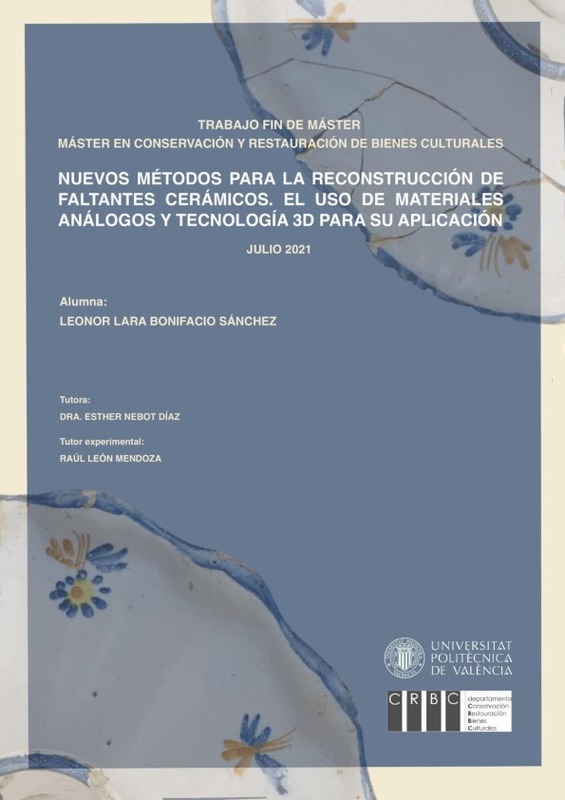|
Resumen:
|
[ES] El presente trabajo final de máster estudia la reintegración volumétrica mediante la tecnología de escaneo, modelado e impresión 3D en objetos artísticos y patrimoniales de cerámica. El objeto de estudio es un plato ...[+]
[ES] El presente trabajo final de máster estudia la reintegración volumétrica mediante la tecnología de escaneo, modelado e impresión 3D en objetos artísticos y patrimoniales de cerámica. El objeto de estudio es un plato de mancerina de la Real Fábrica de Alcora perteneciente al estilo decorativo del Ramito, serie popular de finales del siglo XVIII y principios del siglo XIX, propiedad de una colección particular. Se realiza un breve repaso histórico y estilístico de la pieza, así como su caracterización; y se analiza el uso actual de las tecnologías 3D en la conservación y restauración del patrimonio. Este trabajo de investigación se centra en la experimentación de distintos materiales, en los que las tecnologías 3D conforma un pilar fundamental para obtener la reconstrucción de faltantes cerámicos, con el fin de conseguir una reintegración volumétrica menos invasiva en su ejecución. Los materiales de estudio se han determinado según diversos criterios y se establece una comparativa en función de la viabilidad, la compatibilidad, el coste económico, la mínima manipulación del objeto intervenido y la responsabilidad medioambiental del proceso y del material empleado. Los materiales seleccionados son: filamento de impresión 3D de ácido poliláctico (PLA), resina cerámica de impresión 3D y pasta cerámica de baja cocción con formula estipulada. Para concluir, se establece un protocolo de ejecución que facilite la reproducción de esta metodología en futuras reintegraciones volumétricas de objetos cerámicos.
[-]
[EN] This master's thesis studies volumetric reintegration through scanning, modeling and 3D printing technology in artistic and patrimonial ceramic objects. The object of study is a mancerina plate from the Real Fábrica ...[+]
[EN] This master's thesis studies volumetric reintegration through scanning, modeling and 3D printing technology in artistic and patrimonial ceramic objects. The object of study is a mancerina plate from the Real Fábrica de Alcora belonging to the Ramito decorative style, a popular series from the late 18th and early 19th centuries, owned by a private collection. A brief historical and stylistic review of the piece is carried out, as well as its characterization; and the current use of 3D technologies in the conservation and restoration of heritage is analyzed. This research work focuses on the experimentation of different materials, in which 3D technologies form a fundamental pillar to obtain the reconstruction of missing ceramics, in order to achieve a less invasive volumetric reintegration in their execution. The study materials have been determined according to various criteria and a comparison is established based on viability, compatibility, economic cost, minimal manipulation of the intervened object and the environmental responsibility of the process and the material used. The selected materials are: polylactic acid (PLA) 3D printing filament, 3D printing ceramic resin and low-firing ceramic paste with a stipulated formula. To conclude, an execution protocol is established to facilitate the reproduction of this methodology in future volumetric reintegrations of ceramic objects
[-]
|







